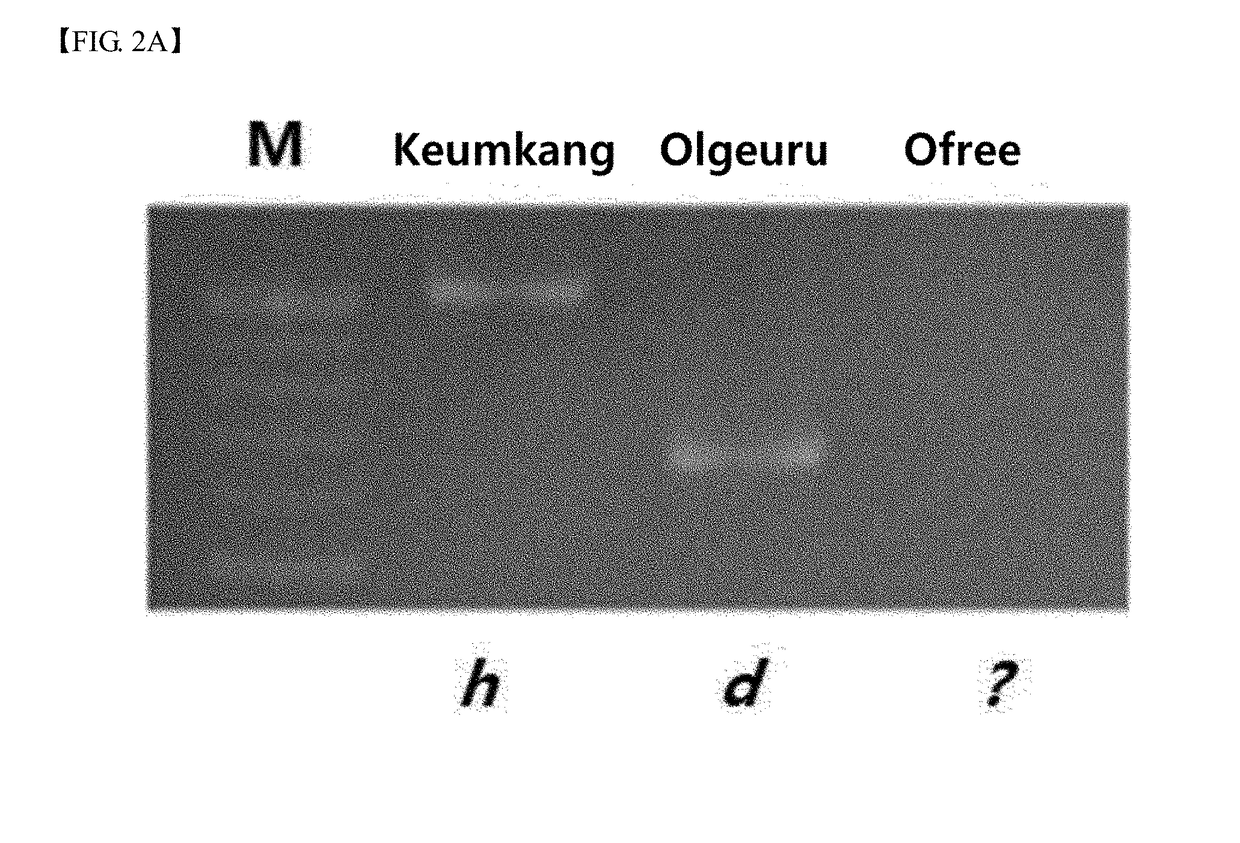Wheat for improvement and prevention of gluten intolerance and wheat-dependent exercise-induced anaphylaxis
a technology of wheat and gluten intolerance, which is applied in the field of wheat cultivars for improving and preventing gluten intolerance and wheat-dependent exercise-induced anaphylaxis, can solve the problems of serious illness, poor absorption of nutrients, and inability to easily absorb nutrients, so as to prevent the onset of celiac disease and not induce gluten intoleran
- Summary
- Abstract
- Description
- Claims
- Application Information
AI Technical Summary
Benefits of technology
Problems solved by technology
Method used
Image
Examples
example 1
nt of New Wheat Variety
[0060]A novel wheat cultivar having high cold resistance and desirable growth habit was developed by artificially crossing Keumkang and Olgeuru to obtain a progeny wheat plant F1. Haploid of F1 was cultivated at CIMMYT in Mexico and testing the productivity of F1 for four years in Iksan. The novel wheat cultivar was named “Ofree” (FIG. 1).
[0061]FIG. 1 is a genealogy diagram for illustrating the process of developing a new wheat cultivar Ofree.
example 2
Identification of Ofree
Example 2-1. Confirmation of Deletion of Genes Located at Glu-B3 Loci
[0062]The genetic characteristics of Ofree developed by the processes described in Example 1 were determined in terms of the expression levels of genes at the Glu-1 loci components of high-molecular-weight glutenin subunits (HMW-GSs) in gluten and genes at the Glu-3 loci that is components of low-molecular-weight glutenin subunits (LMW-GSs) in gluten.
[0063]In brief, a genomic DNA extraction kit for plants (SolGent Co., Ltd., Korea) was used to extract genomic DNA from the young leaves of Keumkang, Olgeuru and Ofree. Subsequently, polymerase chain reaction (PCR) was carried out using the genomic DNA extracted earlier as a template and primers capable of detecting genes at the Glu-A1, Glu-B1, Glu-D1, Glu-A3, Glu-B3 or Glu-D3 loci (listed below) to determine which of the genes at the Glu-1 and Glu-3 loci were contained in the genetic composition of Ofree (Table 1).
Glu-A1ab F:(SEQ ID NO: 1)5′-AAG...
example 2-2
n of Deletion of ω-5 Gliadin Genes in Ofree
[0071]Gliadin extraction was performed by consulting a prior-art document (Dziuba M, Nałȩcz D, Szerszunowicz I, Waga J. 2014. Proteomic analysis of wheat α / A- and β-gliadins. Czech J Food Sci 32: 437-442). 1 ml of a 0.15 M aqueous NaCl solution was mixed with 100 mg of each of finely pulverized Keumkang, Olgeuru, and Ofree. Each mixture was reacted for two hours at 25° C., centrifuged at the speed of 15,000 rpm at 20° C. for five minutes, and then a supernatant thereof was removed. The precipitate was mixed with 1 ml of a 70% aqueous ethanol solution, the mixture was reacted for 12 hours at a constant temperature and centrifuged at the speed of 15,000 rpm at 20° C. for five minutes, and then a supernatant of the mixture was stored at 20° C.
[0072]Sodium Dodecyl Sulfate Polyacrylamide Gel Electrophoresis (SDS-PAGE) Analysis and Results
[0073]A gliadin stored at −20° C. was mixed with a sample buffer (50 mM Tris-HCl, pH 6.8, 8% β-mercaptoethano...
PUM
 Login to View More
Login to View More Abstract
Description
Claims
Application Information
 Login to View More
Login to View More - R&D
- Intellectual Property
- Life Sciences
- Materials
- Tech Scout
- Unparalleled Data Quality
- Higher Quality Content
- 60% Fewer Hallucinations
Browse by: Latest US Patents, China's latest patents, Technical Efficacy Thesaurus, Application Domain, Technology Topic, Popular Technical Reports.
© 2025 PatSnap. All rights reserved.Legal|Privacy policy|Modern Slavery Act Transparency Statement|Sitemap|About US| Contact US: help@patsnap.com



